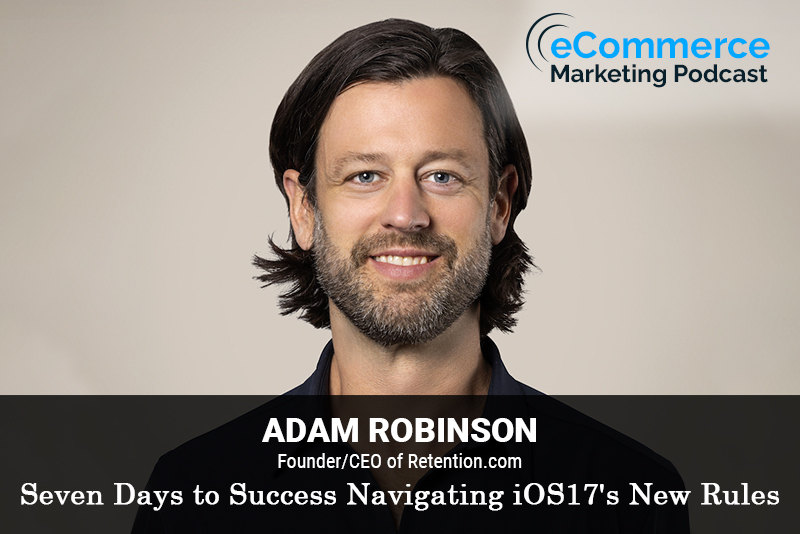
The eCommerce Marketing Podcast walks you through everything that goes into ecommerce marketing — from inbound marketing to paid advertising to conversions. Learn the strategies top marketing experts use to grow their businesses.
Adam is a serial entrepreneur and the founder/CEO of Retention.com, which helps DTC brands grow their email list 10-15x faster than any other way. He has bootstrapped the company to 20m ARR in 3 years, and sold his last company to private equity for an eight figure exit. Adam is the host of the “10 Years in the Making” podcast, is creating a weekly work-in-public docuseries called “Billion Dollar Challenge”, and posts daily on linkedin and twitter. Adam is an expert in email marketing, list growth, data, compliance, and building software companies.
In this episode, you will learn
- How the iOS17 update has altered the user tracking landscape for platforms like Klaviyo and Meta
- How does the reduction from a 2-year tracking window to just 7 days fundamentally change marketing strategies for ecommerce brands
- The effects of the iOS14 and iOS17 updates on ecommerce marketing?
- What are the most immediate challenges that ecommerce brands are facing due to this reduced tracking capability
- Given these new limitations, the strategic shifts that are recommended for ecommerce brands looking to maintain effective marketing campaigns
- For brands that are just now becoming aware of these changes, what are the first steps they should take to adapt their marketing strategies effectively
Head over to leadfeeder.com and sign up for a 14-day (no strings attached) free trial
For show transcript and past guests, please visit
https://www.ecommercemarketingpodcast.com
Or on YouTube at: https://www.youtube.com/channel/UC3PgT0NOGzpdPGQtBK0XLIQ
Follow Arlen:
Twitter: https://twitter.com/askarlen
Facebook: https://www.facebook.com/arlen.robinson.7
Instagram: https://www.instagram.com/arlenyohance/
LinkedIn: https://www.linkedin.com/in/arlenrobinson/
Past guests on the ecommerce marketing podcast include Neil Patel, Nemo Chu, Luke Lintz, Luke Carthy, Amber Armstrong, Kris Ruby and many more.
Thanks for listening. Be sure to subscribe and leave a review

In this episode of the eCommerce Marketing Podcast, host Arlen Robinson welcomes Adam Robinson, a serial entrepreneur and the founder/CEO of Retention.com. Adam discusses his journey of bootstrapping Retention.com to a $21 million ARR in four years and shares insights on navigating the recent changes in data tracking due to Apple’s iOS 17 update. The conversation highlights strategies for e-commerce brands to adapt to the new limitations on tracking users and the importance of first-party data.
Key Takeaways
- Introduction and Background ([00:03] – [02:47])
- Adam’s journey from previous ventures to founding Retention.com.
- Achievements: Bootstrapped to $21 million ARR in four years.
- Impact of iOS 17 Update ([03:15] – [08:45])
- Apple’s iOS 17 reduces user tracking from two years to seven days.
- Challenges and limitations for brands due to this significant change.
- Strategies to Navigate Changes ([08:45] – [11:48])
- Importance of first-party cookies for better tracking.
- Recommendations of vendors: Elavar, Blotout.io, Black Crow, and Retention.com for server-side tracking solutions.
- Impact on Marketing Strategies ([11:48] – [15:45])
- Changes needed for marketing on Meta (Facebook, Instagram).
- Significance of event match quality score and using the conversions API for better data tracking.
- Future of Tracking and Practical Steps ([16:37] – [19:07])
- Predictions on further limitations and the importance of being adaptable.
- Practical steps: Focus on building and optimizing email and SMS lists for direct customer engagement.
- Key Advice for E-commerce Brands ([19:07] – [27:33])
- Importance of setting up add-to-cart email flows in Klaviyo for better conversion rates.
- Regularly checking and improving event match quality scores.
- Final Thoughts and Fun Fact ([28:02] – [29:45])
- The need for brands to control their customer data and form direct relationships.
- Adam’s fun fact: His six-pound Chihuahua and wiener dog mix that keeps him company while working.
Guest Info
Adam Robinson
Founder/CEO of Retention.com
Email: [email protected]
LinkedIn: Retention Adam











